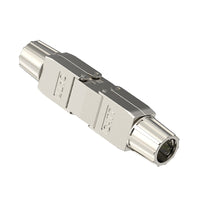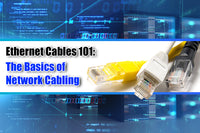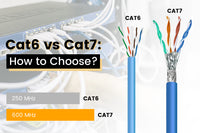Have you ever tried to buy an Ethernet cable online and DIY your wired connection? Do you have no idea about how to identify the Ethernet cable? Does the Ethernet cable category matter? What’s the meaning of a network cable jacket? Reading Ethernet cable specifications can be challenging for beginners, and you’re here in the right place.
Ethernet Cable Specs
If you purchase an Ethernet cable from a professional supplier, you’ll find the corresponding cable specification on the data sheet or cable jacket. Here are some Ethernet cable specifications you should know before buying an Ethernet cable.
- Ethernet Cable Category: Described as CAT. Up to now, there are various versions of Ethernet cables, including Cat5, Cat5e, Cat6, Cat6a, Cat7, and the latest version Cat8. They have different performances, and you should do the search before buying.
- Cable Jacket Ratings: Cable jackets are designed to protect the cable’s conductor from physical damage and the exterior environment. It is essential to use the correct cable jacket when cables are installed through walls, under the floor, or outdoors. The four main ratings of cable jackets are CM/CMG, CMX, CMP, and CMR. CM is the most basic type, CMP is generally used for plenum applications, and CMX is for outdoor applications.
- Cable Shielding Types: Cable shielding can be divided into F/UTP, U/FTP, S/UTP, SF/UTP, F/FTP, S/FTP, and SF/FTP. In some situations, people may refer to “U/UTP” as “UTP” and “F/UTP” as “FTP.” Learn more information in Shielded vs. Unshielded Ethernet Cable.
- Wire Gauge: Wire thickness is often described as wire gauge. When buying CAT5E, CAT6, or CAT6A Ethernet cables, you may find the cable jacket is printed with AWG. What does it mean? The full name of AWG is American Wire Gauge. In general, the larger the AWG, the thinner the wire diameter.
- Maximum Installation Temperature: The Ethernet cable jacket is often printed with the maximum operating temperature to ensure maximum cable performance.
- Cable bandwidth: Another specification you will find on the cable jacket is the cable bandwidth in MHz, for example, 250 MHz.
|
Cable Types |
CAT5 |
CAT5E |
CAT6 |
CAT6A |
CAT7 |
CAT8 |
|
Bandwidth |
100 MHz |
100 MHz |
250 MHz |
500 MHz |
600 MHz |
2000 MHz |
- Cable jacket material: PVC is the primary material for most Ethernet cables for its flexibility and cost-effectiveness. There are also other materials for different applications such as PUR, PE, and CPE. PVC cable jacket can cause toxic gas if burned, so in some highly enclosed places, it should be replaced by LSZH cable jacket (Low Smoke Zero Halogen) for added safety.
- Conductor material: The Ethernet cable quality varies on the market. The cable conductor can be made of copper-clad aluminum or copper. Remember that copper-clad aluminum is of poor quality, affecting the network data transmission. You’d better choose a pure copper conductor.

Other Technical Terms
- ANSI/TIA: The full name of ANSI is American National Standards Institute, and TIA isTelecommunications Industry Association. The Ethernet cables are often made according to ANSI/TIA standards.
- T568A/T568B: These are two defined wiring standards for Ethernet cables. No one is better than the other. People tend to use the T568B wiring diagram, but you can choose one according to your needs.
- Patch Cables: Also named patch cords. Patch cables are Ethernet cables terminated with RJ45 connectors on both ends. They are often used to connect your computer to the router or keystone jack in the wall. Patch cables should not be used for long-distance applications.
- Structured Cabling: Structured cabling means the building telecommunication cabling infrastructure that consists some elements. The structured cabling uses bulk cables in the ceiling or through the wall.
- PoE: PoE is defined as Power over Ethernet, meaning that you can only run a single Ethernet cable to provide power and data at the same time. PoE is often used for IP cameras and wireless access points.
- Crossover Cable: This kind of cable is terminated with T568A at one end and T568B at the other. Crossover cable was used in the past, but it was never used in modern networks.
- Twist Rate: An Ethernet cable features four twisted pairs. Do you know why eight conductors are twisted into pairs? Twisting wires is a common way to reduce crosstalk and interference. The twist rate depends on different manufacturers, and not all twisted pairs have the same twist rate for further interference resistance.
Final Words
Knowing the basic technical terms and specifications will help you know more about Ethernet cables. Hope this brief guide can inspire you a lot. If you have any other questions, feel free to leave your reviews.
For more information on this topic, you can keep up on our blogs. While VCELINK offers general and basic information for our customers and other visitors to the website, it’s not professional advice.




Be the first one to comment.
Leave a comment